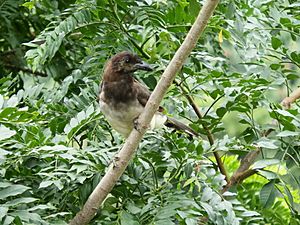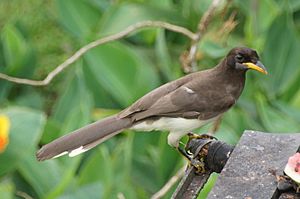Brown jay facts for kids
Quick facts for kids Brown jay |
|
|---|---|
 |
|
| Adult bird. Aserrí, Costa Rica |
|
| Conservation status | |
| Scientific classification | |
| Genus: |
Psilorhinus
|
| Species: |
morio
|
 |
|
| Range (click to magnify) | |
| Synonyms | |
|
Cyanocorax morio |
|
The brown jay (Psilorhinus morio) is a large American jay. It looks a bit like a magpie but is slightly smaller. It has a shorter tail and a bigger beak.
You can find brown jays from Mexico south into Central America. They live along the Gulf of Mexico coast. The farthest north they live is in the Rio Grande Valley in Texas.
Contents
What Does the Brown Jay Look Like?
Brown jays look a little different depending on where they live. There are two main groups:
- Northern birds are mostly dark brown. Their bellies are a lighter brown.
- Southern birds have white bellies. They also have bright white tips on their outer tail feathers.
These two groups meet in Veracruz, Mexico.
Adult brown jays have black beaks, legs, and feet. Young brown jays (called immatures) have yellow beaks, legs, and feet. They also have yellow rings around their eyes.
The brown jay's voice is a loud, low-pitched pee-ah call. They can change this call depending on what they want to say or how they feel.
Where Do Brown Jays Live?
In Central America, you won't find brown jays in El Salvador. Instead, they live on the Pacific side of Central America. This includes Nicaragua, Costa Rica, and western Panama. They do not live in South America.
What Do Brown Jays Eat?
Brown jays mostly look for food in trees. But they also find some food on the ground. They eat many different things. Their diet includes:
- Insects and other small creatures without backbones.
- Small lizards.
- Nectar from flowers.
- Fruits, like those from the Trophis racemosa tree.
Sometimes, they might eat eggs and baby birds from other nests. But they usually only do this if there isn't much other food around.
How Do Brown Jays Build Their Nests?
Brown jays build their nests in trees or large bushes. Both the male and female birds help build the nest.
- They usually lay about three eggs, but sometimes they can lay up to six.
- The eggs hatch in about 18 to 20 days.
- Only the female bird sits on the eggs to keep them warm. The male bird brings her food while she is on the nest.
Sometimes, young birds from a previous year will help their parents raise new chicks. If a helper bird brings food, it gives it to one of the parent birds. Then, the parent bird feeds the food to the chicks.
See also
 In Spanish: Chara Papán para niños
In Spanish: Chara Papán para niños
Images for kids
-
Adult bird.
Aserrí, Costa Rica






